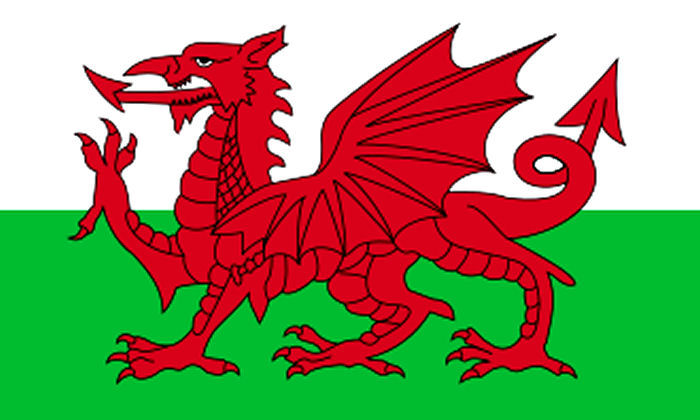
Welsh~American Day
01 March 2021

The American Community Survey, compiled between 2008 and 2012 and being the most recent analysis, identified 1% of the total population of Bedford County as descending from Welsh ancestors.
The day of national pride for the Welsh and descendants of Welsh ancestors who immigrated to North America is the day dedicated to St. David who was born in Caerfai, south-west Wales. The date on which the holiday falls, 1 March, honors the date on which the canonized Saint David died in 589 AD.
St. David's Day, as the title suggests, was established by the Catholic Church as one of its Saints' holy days. St. David was born in southwest Wales into an aristocratic family, the royal house of Ceredigion. When he grew up David joined a Celtic monastery and he himself would later found the monastic community of Glyn Rhosyn (i.e. The Vale of Roses) in Pembrokeshire. St. David's Cathedal stands there to this day. David also helped to found twelve other monasteries. In the year 1120, Pope Callixtus II canonized David as Saint David. His death on 1 March 589 gave rise to this holyday. St. David became recognized as Wales' national patron saint by the 12th Century.
Over the centuries St. David's Day has been celebrated in a fairly solemn manner. Families gather to feast and remember and honor the rich Welsh contribution to the heritage of the United Kingdom. In public, the Welsh and their Welsh~American cousins might wear daffodils and leeks in their lapels. The daffodil, which is called in Welsh, Cenhinen Bedr (i.e. St. Peter's leek) is the national flower of Wales. It should be noted that the leek (a member of the genus, Allium, which includes onions, garlic and chives) is also one the national emblems of Wales. It was said that St. David ate only leeks when he was fasting. Legend also tells us that King Cadwaladr of Gwynedd met the Saxons in battle on a field of leeks. The king ordered the wearing of leeks on his soldiers' helmets during the battle so that they could be distinguished from the enemy.
In regard to the pride of the Welsh people, it was from Wales that the House of Tudor rose to reign over a united England and Wales, and that proud heritage is celebrated on this day. Wales produced King Henry VII (Harri Tudur) who was victorious in the Battle of Bosworth Field over the English King Richard III. The Welsh victory on 22 August 1485, the one that basically ended the War of the Roses, brought an end to the rule of the House of York and began the Tudor Reign. The Tudors would include Henry VIII, Edward VI, Jane I, Mary I and Elizabeth I. It was during the Tudor Dynasty that the Welsh dragon was added to the royal coat of arms.
The modern nation of Wales is one of the four countries that comprise the United Kingdom. While the rest of the world calls them Welsh, the people of Wales refer to themselves as Cymry. [The name is pronounced as kem'-ri.] It is derived from the Brythonic word kombrogi meaning 'fellow countrymen'.
A majority of the Welsh immigrants who made their way to Bedford County took up jobs in coal mining in the northeastern corner of the county. Coal mining was a major industry in their native homelands.
Celebrations on St. David's Day might include a parade and an eisteddfod (a festival of Welsh music and literature). The eisteddfod is often performed by school children with concerts for the parents.
The traditional food dishes of Wales include Welsh rarebit and cawl. Despite the similarity of the name 'rarebit' to 'rabbit', the dish does not include hare. It consists of a hot cheese-based sauce poured over toasted bread. But it isn't a plain old cheese sauce. All recipes include a dash of mustard and butter. Then it is up to the chef to decide what else goes into the sauce. Some add ingredients such as Worcestershire sauce and/or eggs and even Guiness stout (beer). Despite its fame, bearing the name of its origin, Welsh rarebit is normally not served as a dinner or main dish. It is most commonly eaten as a light lunch. Glamorgan sausage a 'vegetarian' sausage also uses cheese as a main ingredient. Cheese and leeks or spring onions are mixed together with a dash of thyme and a bit of mustard. The mixture is then rolled in breadcrumbs mixed with egg yolks into the shape of a sausage. The 'sausage' is then brushed with the egg whites and fried. Cawl [pronounced cow-l] is basically a stew made of lamb or beef and vegetables such as potatoes, carrots, rutabagas and leeks. A neck of lamb is put into a pot with three pints of lamb stock. The lamb in the lamb stock is brought to a boil then the heat is reduced and it is left to simmer for an hour. The vegetables are added and heated for another hour. When the stew is finished cooking, the meat and vegetables are removed and the stock is thickened and made into a soup with the addition of oatmeal or flour. The sauce-like soup would be eaten as a first course, to be followed by the meat and vegetables. Welsh cakes are small round baked pastries which contain raisins, currants and sultana grapes in addition to various spices. Bara Brith is a type of bread containing dried fruit mixed with raisins and flavored with tea in which the fruit mixture soaks overnight. Sugar, flour and egg is added to the fruit mixture and it is stirred into a batter that is cooked into bread. Another traditional dish of the Welsh is crempog, a type of pancake made of flour, eggs, salted butter, buttermilk and vinegar. The national drink of Wales is beer, although whiskey is also very popular.
Perhaps the most unusual food traditionally eaten by the Welsh is a thing called 'laverbread'. It is not really a type of bread. It consists of seaweed named laver that is boiled until it turns to a mush or a gelatinous paste. After being rolled in oatmeal the laverbread is fried and eaten with bacon and 'hog's pudding' a sort of pork sausage.
Additional Information Might Be Added Here. Please Check Back.
Click on this logo to return to the Calendar page.

